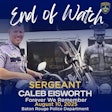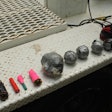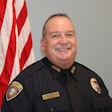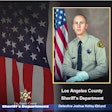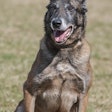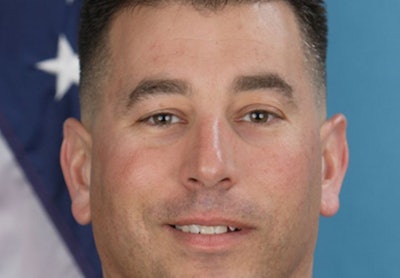 Fremont (Calif.) Police Officer Todd Young. Photo: FPD
Fremont (Calif.) Police Officer Todd Young. Photo: FPD
Like many cops, it wasn't unusual for Fremont, Calif., police officer Todd Young to put in more than an eight-hour work day. August 27, 2010, was no exception. Having already assisted in the service of several DEA warrants that morning in Oakland, Todd and his partner, Eric Tang, decided to lag behind the rest of their task force awhile before heading for the barn.
They did so in hopes of locating a wanted Union City gang member whose ex-girlfriend had said that he'd been hanging out in the area.
Parking on Aueson Street a few doors down from the possible location, they settled into surveillance mode. Their game plan was to get a set of eyes on the perp and then notify Oakland officers and let them take him down. Their vigil lasted until 2:30 in the afternoon when they observed a trio of males congregating around a Chevy Avalanche. The young men's attire—thick clothing and hoodies—stood out on the warm summer day. One of the three closely approximated the description of their quarry: a fat 21-year-old named Andrew Barrientos.
In hopes of getting a marked patrol unit there as soon as possible, Tang rang the Oakland police on his cell phone. But when the males started to open the doors of the Avalanche, both officers realized that their window of opportunity to take down Barrientos, a man who'd reportedly threatened to kill his ex-girlfriend and their six-month-old baby, was closing. That, coupled with the fact that Barrientos was already wanted on a high-speed pursuit warrant, was enough to force their hand: They would try to take him down themselves.
The Fremont officers' hopes hung on whatever element of surprise their unmarked car afforded them on their approach. But as they slowed for a speed bump, Barrientos turned toward them. They might not have been wearing police uniforms, but for Barrientos the sight of a male white and a male Asian was enough—the fat man bolted as fast as his unconditioned legs would allow.
As Barrientos ran down the sidewalk, Young pulled abreast of him. He pulled the car over, told Tang to watch the other gang members, and jumped out. Young then whipped his neck chain badge from the inside collar of his shirt and yelled, "Police! Police!"
Young's commanded Barrientos to stop. Barrientos kept running. Young knew it was up to him to take the suspect down physically. He rapidly closed the distance.
Point Shooting
As both Young and Barrientos neared a street corner, Young mentally prepared himself to shove Barrientos onto his ass before the man could get around the corner. Young hoped this would keep him in eyeline of his partner and prevent Barrientos from carjacking someone or taking a hostage.
[PAGEBREAK]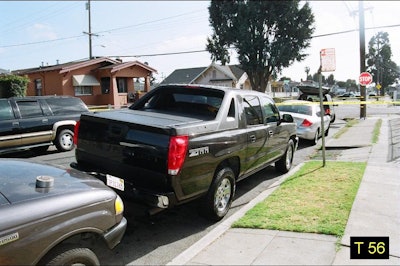 Officer Young first spotted Barrientos from this view on Auseon Avenue near this Chevy Avalanche truck. Photo: Alameda County D.A.
Officer Young first spotted Barrientos from this view on Auseon Avenue near this Chevy Avalanche truck. Photo: Alameda County D.A.
But then Barrientos looked over his shoulder. At the sight of Young closing in on him, Barrientos spun around and began point shooting directly at Young with a 9mm Glock with an extended magazine. Young felt a round tear into his hip. Young drew his .45 caliber SIG, getting off five rounds to Barrientos' 10.
Barrientos continued his rapid-fire technique, firing behind without aiming. It was crude and reckless but at that distance it was also proving effective.
I'm Hit But Not Bad
Young knew that Tang was coming up behind him on the sidewalk and would probably be engaging Barrientos. To avoid compromising either his or his partner’s safety, Young peeled off laterally to his left as his gait slowed to a tactical walk. Once at the opposite side of the street, Young proned himself out on the asphalt and tried to get a bead on the suspect whose bouncing shoulders he could see above those cars parked against the curb.
Just then, Tang pulled up abreast of his partner.
"Where is he?"
Young's answer came in the form of his aiming at the suspect and firing two more rounds as his partner dropped to one knee and let loose with three of his own. Young decided to keep a few rounds in reserve in case they got flanked by the suspect's two friends.
Barrientos disappeared around a corner some 60 yards down the street.
Young rocked up to his knees.
"I'm hit," he told Tang. "But I'm all right. You watch those guys and I'll keep an eye on the corner."
As Tang monitored the suspects' acquaintances and Young kept a look-out in case their assailant doubled back, he began applying direct pressure to his hip injury.
Police sirens wailed toward them. Throughout the incident, Tang had left his cell phone line open so that Oakland dispatch could monitor what happened. That, coupled with the shooting being captured by a Shotspotter acoustic sensor, meant that the Oakland PD knew what had happened and where. Young found himself quickly surrounded by officers, one of whom pulled out a trauma kit as another started to cut off Young’s pants. Young helped as best he could by unsnapping his drop holster and belt and handing it to one of the Oakland guys.
"I'm all right," he assured his partner again as he continued to apply direct pressure on the wound.
That wasn't good enough for an Oakland officer, nor was the lack of response he was getting on an ETA of the ambulance.[PAGEBREAK]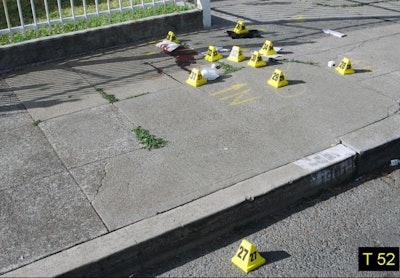 The sidewalk where Oakland officers performed trauma care on Officer Young. Photo: Alameda County D.A.
The sidewalk where Oakland officers performed trauma care on Officer Young. Photo: Alameda County D.A.
"We're taking you," he said, and with that Young was loaded into a patrol car and transported to the hospital.
Hemmorhage
The ensuing ride was a wild one, one that scared Young more than the shooting. As the car rocked back and forth with each hairpin turn, an Oakland officer used gauze to put direct pressure on Young's wound.
As Young lay in the back of the patrol unit, he seethed. Pissed off that he'd gotten shot, he was even angrier that he hadn't been able to return the favor to his assailant. That and the fact that the man had apparently made good his escape.
Still, he was a good less worried than he thought he would have been. Just getting loaded into the car had been a lift in more ways than one. The sight of an assembled trauma team in the Highland Hospital ER parking lot dissipated any anxieties that much further.
A doctor took Young's vitals and showed him where the bullet entry and exit wounds were. Initially, doctors estimated that Young would be out of the hospital in two hours.
But during a CT scan he began hemorrhaging and they soon found that his body was very nearly depleted of blood: His iliac artery had been hit.
Doctors saved Young’s life. But the road to recovery Young would face would be as steep as it would be long.
The Shooter
Barrientos made good his escape—for a day. One reason that Barrientos was able to evade capture even that long was that he'd worn a white hoodie beneath his black hoodie, a common practice among gang members.
He discarded the first hoodie after dumping a car that he'd stolen in a carjacking seconds after the shoot-out. Investigators looked in nearby garbage cans and found the hoodie that matched the one he had been wearing. The DNA on the garment belonged to Barrientos. The hoodie had one bullet hole in it.
After fleeing to Southern California, Barrientos was arrested by a San Diego police sergeant near the Mexican border a day following the shooting. He was ultimately convicted of attempted murder and nine other felonies and sentenced to life in prison.
Young and Tang have since discussed their frustration in not being able to take the man down.
"Because I had failed to take him down, two additional people got shot at [during subsequent carjack attempts]. That really bothered me. I felt that I hadn’t done my job," Young says.
Even so, with rounds bouncing off of a wrought iron fence to his right and cars to his left, and limited ammunition in his magazine, Young believes there wasn't much else he and Tang could have done.
"I was trying to pick up my front sights on every shot," recalls Young. "But cops can have a hard time just hitting a stationary target. It’s that much harder trying to hit something when it's moving, you’re moving, and you've been shot. I knew he got lucky with that first shot. He didn’t kick my ass. I didn’t feel like I lost the gunfight. It was like the guy who sucker punches you and runs away. He didn’t stand his ground. But I feel terrible that I was trying to shoot this guy and put him down, but he got away."[PAGEBREAK] Andrew Barrientos shows off his forearm gang tattoos "DeCoto" and "Gangsta." Photo: Alameda County D.A.
Andrew Barrientos shows off his forearm gang tattoos "DeCoto" and "Gangsta." Photo: Alameda County D.A.
Fortunately, no one else got hurt and Young ultimately trumped Barrientos' efforts to kill him.
"One of the reasons I survived was my fighting mindset, a winning mindset, if you will. You have to keep that mindset at all times—when you're in the heat of the battle, in surgery, and in rehab. You have to fight the pain and get through it."
Young takes pains to emphasize the import of Simunition round training, crediting it as a huge factor in his survival.
"The first time you get hit in Simunition training, you’re expecting it so the adrenaline thing is working for you. You don’t feel it that much. But I noticed that the more SWAT training I did, the more it would sting when I'd get hit with M4 Simunition rounds. Those things are coming out at a pretty good clip and they hurt, especially when they hit your fingers on a cold day. But they reinforce the desire not to get hit by them—Also, I hate washing pink paint out of my SWAT gear—but more than that they condition you to fight through whatever pain you are experiencing and stay in the fight."
Young notes that both he and Tang did everything that they'd expected of themselves during such an operation.
"Neither of us rose to the occasion," he notes. "Both of us fell to our level of training."
Faced with a similar situation again, Young would do one thing differently: He would have retained his SWAT gear after the DEA operation.
"I had my M4 with an EOTech holographic weapon sight in the car, but unfortunately that was where it remained when I went after the guy. I'm pretty good with the weapon and believe that even wounded I would have taken out the suspect even at 60 yards and prevented any civilians from being harmed. I wouldn’t have had to fire a bunch of times to hit him."
Beyond such objective appraisals, Young doesn't Monday morning quarterback himself on the incident; at times, he and his friends have even found humor in what happened.
"Later on we could laugh about some of it," Young says. "Guys would say of the suspect, 'He was running? Hell, man, he was waddling! And you couldn't hit him?' The female officer who'd helped me in the patrol unit did a presentation at a Women Leaders in Law Enforcement conference. She joked to some 500 hundred people that here she was worried that I was about to pass out and die and this 'tough son-of-a-bitch' is monitoring radio communication and correcting suspect information as it’s being broadcast. That kind of thing ultimately takes the edge off of things and makes you feel better."
There was one conversation that was more difficult. The one when he returned home from the hospital and was called on the broken promise he'd made to his six-year-old daughter.
"Daddy," she said, hands on her waist and head shaking back and forth in an admonishing manner. "I thought you said that you wouldn't get shot. That good guys don't get shot."
"Yeah, I got shot," he conceded sheepishly before offering his best defensive reminder. "But, hey, I didn't die."
Young might have felt sheepish fessing up to having broken his promise, but more than that he was grateful that he was still around to do it.
He shares his story with other officers in the hope that they won't have to break similar promises to their children.
What Would You Do?
Put yourself in the shoes of Officer Todd Young of the Fremont (Calif.) Police Department and responding members of the Oakland Police Department, and consider the following questions:
- Are you more apt to wait for EMS units to respond, or to roll the officer yourself? What are the pros and cons?
- Confronted with the same situation, would you attempt to stop the subject then and there? What other options might you explore?
- The subject was armed with an extended magazine. What is your agency's policy on carrying them? Do you have any available to you?
Related:










